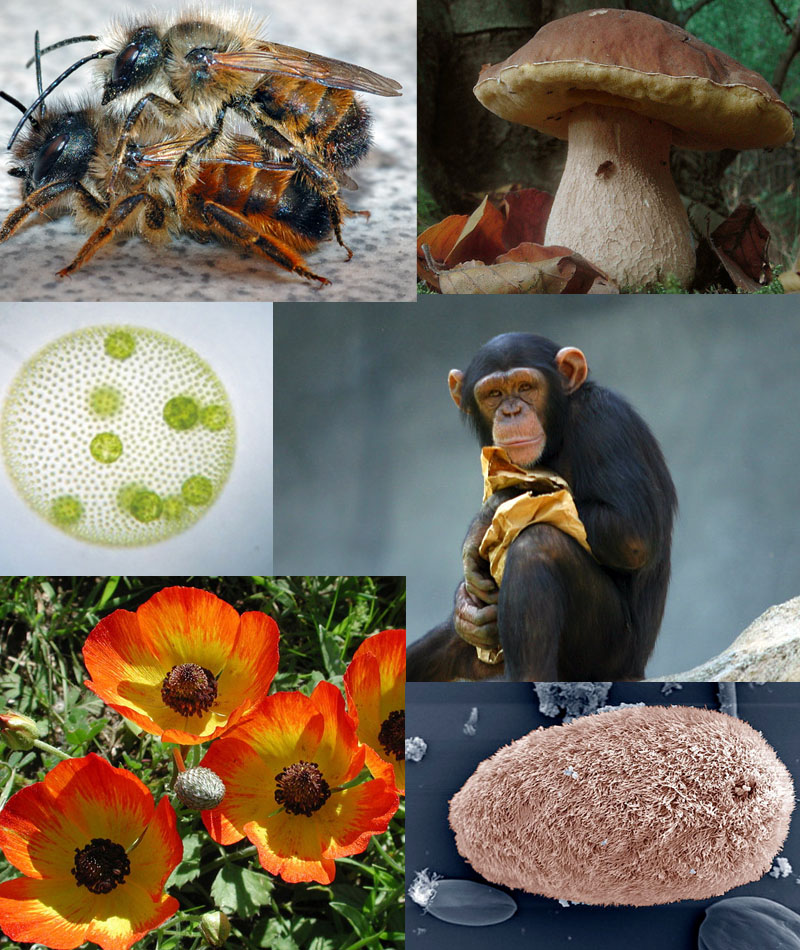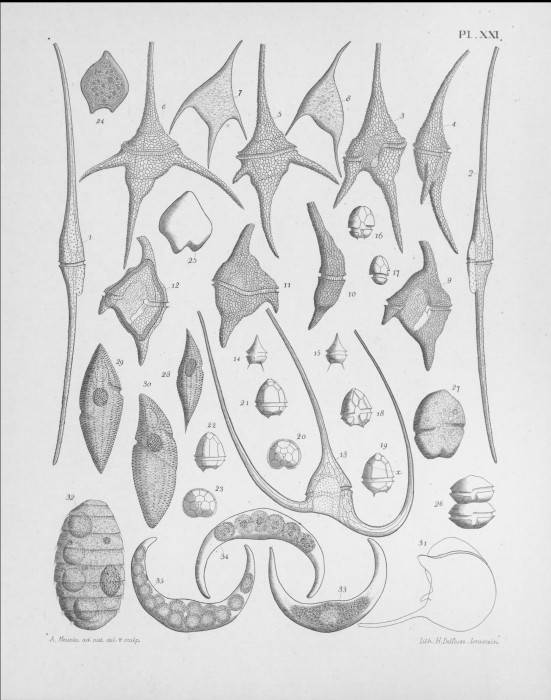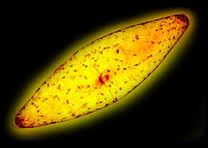Oh Where Art Thou Classified...
Classification
Since most of us have had a Biology class at one time or another, this may sound a little familiar. When naming an organism it will generally have eight parts to its name: Domain, Kingdom, Phylum, Class, Order, Family, Genus, and Species. This classification scheme begins with Domain as the broadest level, and then eventually narrows down to Species. These levels of classification help organize organisms into a hierarchy that makes understanding the relationship between organisms better. It also makes it easier to locate them in a phylogeny.
Pyrocystis fusiformis was orginally named by C.W.Thomson and Murray & Whitting in 1876 (Guiry and Guiry 2013). It has the following classification:
 Domain: Eukarya
Domain: Eukarya
Major Clade: Alveolata
Kingdom: Dinoflagellata
Phylum: Dynophyta
Class: Dinophyceae
Order: Pyrocystales
Family: Pyrocystaceae
Genus: Pyrocystis
Species: Pyrocystis fusiformis
Domain- Eukarya
 There
are three domains: Bacteria, Archaea, and Eukarya. The defining
characteristic of Eukarya is the presence of a nucleus. The nucleus
is a cellular oganelle that contains the organism's DNA. Pyrocystis
fusiformis is classified in Eukarya because it contains a nucleus.
There
are three domains: Bacteria, Archaea, and Eukarya. The defining
characteristic of Eukarya is the presence of a nucleus. The nucleus
is a cellular oganelle that contains the organism's DNA. Pyrocystis
fusiformis is classified in Eukarya because it contains a nucleus.
Major Clade- SAR Group: Alveolata
 SAR includes the
major clades of Stramenopila, Alveolata, and
Rhizaria. Ancestors of the SAR group engulfed an entire red
algae
plant cell, which became their chloroplast. This is known as a
secondary plastid.
Pyrocystis
fusiformis
is known to have a secondary plastid because its cholorplast has 3
membrane layers. Thus, it is classified in the SAR group. Pacific
rockweed in the picture to the right is also a member of the SAR
group.
SAR includes the
major clades of Stramenopila, Alveolata, and
Rhizaria. Ancestors of the SAR group engulfed an entire red
algae
plant cell, which became their chloroplast. This is known as a
secondary plastid.
Pyrocystis
fusiformis
is known to have a secondary plastid because its cholorplast has 3
membrane layers. Thus, it is classified in the SAR group. Pacific
rockweed in the picture to the right is also a member of the SAR
group.
 Pyrocystis
fusiformis belongs to Alveolata due to the presence of
theca plates, or cortical alveoli. These are large, flattened
vesicles located underneath the plasma membrane. All organisms
classified as Alveolata have these cortical alveoli. These plates
act as a sort of armor for the organism.
Pyrocystis
fusiformis belongs to Alveolata due to the presence of
theca plates, or cortical alveoli. These are large, flattened
vesicles located underneath the plasma membrane. All organisms
classified as Alveolata have these cortical alveoli. These plates
act as a sort of armor for the organism.
Kingdom- Dinoflagellata
This organism belongs in the
Dinoflagellata kingdom. All
dinoflagellates have two flagella in
at least one phase of their life cycle. They also tend to be
unicellular protists (not plants, animals, or fungi). "Dinos" is
Greek for whirling, so the name literally means "whirling flagella"
(Campbell et al. 2008). Dinoflagellates earned this name because
their paired flagella make them spin or whirl through the water.
Pyrocystis fusiformis belongs in this kingdom because it is a
unicellular protist that has the paired flagella in one phase of its
life cycle.
Many of the dinoflagellates are also bioluminescent as is
Pyrocystis fusiformis.
Phylum- Dynophyta
Pyrocystis fusiformis is in the phylum
Dynophyta because it has two different flagella,
one posterior and one transverse. The posterior flagella extends
from a groove called the "sulcus" while the transverse flagella
wraps around the cell (Delwiche 2007).
Class- Dinophyceae
 Pyrocystis
fusiformis is classified in Dinophyceae because when
reproducing, its chromosomes remain condensed and do not expand.
Class Dinophyceae is also known as the "Dinoflagellata of
zoologists." This class links ancestral dinoflagellates with
standard morphology (Sarjeant 1974).
Pyrocystis
fusiformis is classified in Dinophyceae because when
reproducing, its chromosomes remain condensed and do not expand.
Class Dinophyceae is also known as the "Dinoflagellata of
zoologists." This class links ancestral dinoflagellates with
standard morphology (Sarjeant 1974).
Order- Pyrocystales
This order was created by Apstein in 1909 and as recorded contains
18 species (Guiry and Guiry 2013). In the name of this order,
it has the prefix of Pyro, meaning light. This is indicative of the
bioluminescent species that this order contains.
Below is a phylogeny of Pyrocystis fusiformis from kingdom through species, based on morphological evidence.
Family- Pyrocystaceae
This family was split into
two different genera, Dissodinium and Pyrocystis. It was created by
(Schütt) Lemmermann in 1899 (Guiry and Guiry 2013). Organisms belonging to this family are
classified by their free-swimming dinospores. These dinospores
eventually lose their flagella and thus the adult stage is
non-motile (Sarjeant 1974).
Genus- Pyrocystis
 Organisms
in this genus reproduce by aplanospores and have thecate in their
motile stage (Elbrachter). There are two parts to this name, "Pyro"
meaning fire or light and "cyst" meaning cell. Put together, the
name "Pyrocystis" means lighted cell. This refers to its
bioluminescent ability. "Cyst" could also refer to the fact that
it reproduces by forming cysts.
Organisms
in this genus reproduce by aplanospores and have thecate in their
motile stage (Elbrachter). There are two parts to this name, "Pyro"
meaning fire or light and "cyst" meaning cell. Put together, the
name "Pyrocystis" means lighted cell. This refers to its
bioluminescent ability. "Cyst" could also refer to the fact that
it reproduces by forming cysts.
Species- Pyrocystis fusiformis
The full binomial name of this species is Pyrocystis fusiformis. This species is a bioluminescent unicellular organism in a fusiform shape, which is where its species name comes from. Fusiform is a shape that tapers at both ends (think of a spindle).
The following is a phylogeny of Pyrocystis fusiformis from Domain to Kingdom. Pyrocystis fusiformis is a eukaryote because it contains a nucleus. It belongs to Alveolata because it has cortical alveoli. It is a dinoflagellate because of its paired flagella and unicellularity. This phylogenetic tree is based on morphological evidence.
"Wait, who is my Daddy?"
-Pyrocystis fusiformis
Want to know where Pyrocystis fusiformis lives? Go to Habitat.
To continue your discovery of various organisms, you can visit other webpages created by Organismal Biology students at MultipleOrganisms.net.
To visit UW-La Crosse's website,
click here.


